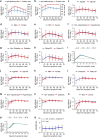Temporal antibody responses to SARS-CoV-2 in patients of coronavirus disease 2019
- PMID: 32983570
- PMCID: PMC7490261
- DOI: 10.1038/s41421-020-00209-2
Temporal antibody responses to SARS-CoV-2 in patients of coronavirus disease 2019
Keywords: Autoimmunity; Immunology.
Conflict of interest statement
Conflict of interestThe authors declare that they have no conflict of interest.
Figures

References
-
- World Health Organization. Coronavirus disease (COVID-2019) situation reports (World Health Organization, 2020).
Publication types
LinkOut - more resources
Full Text Sources
Miscellaneous

